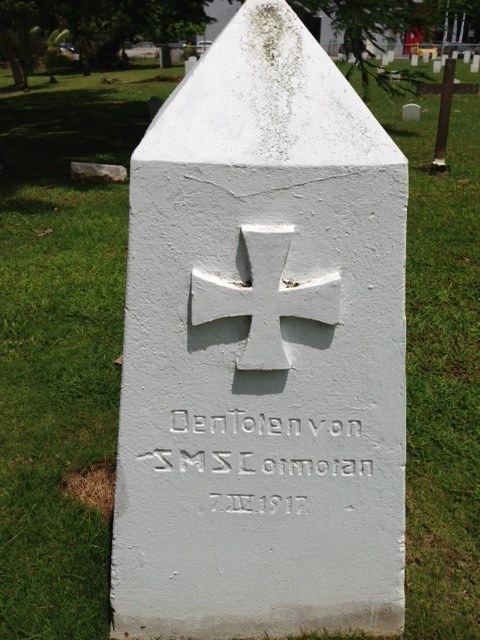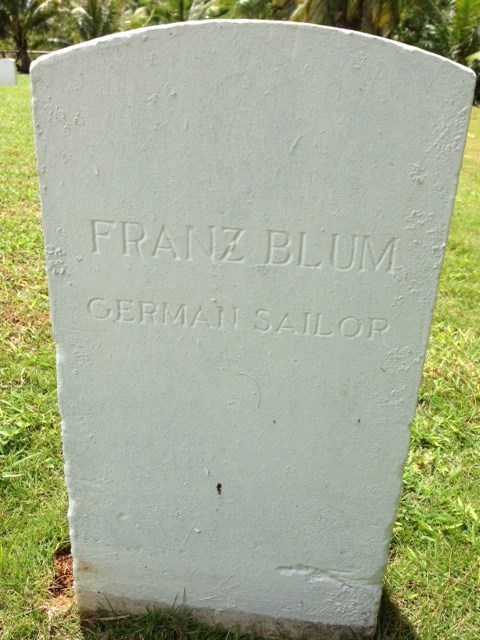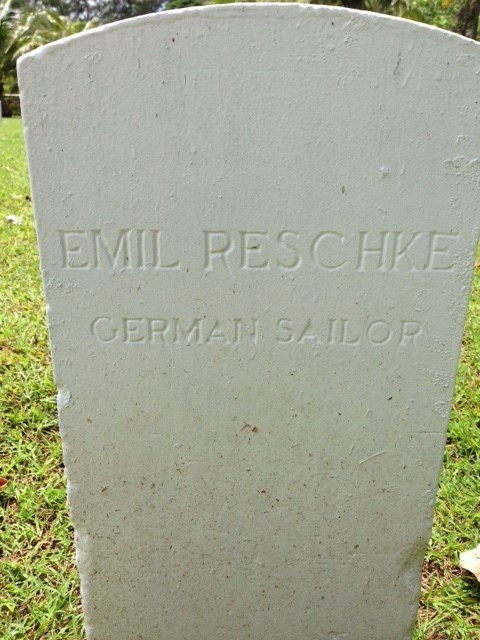Also buried in the Agaña Cemetery are the remains of thirteen German sailors, who died while supposedly scuttling their own ship, the Cormoran (or died thereafter on Guam).
Accounts of the event differ, but what is known is that nine Germans were killed during the scuttling of the Cormoran, either by the explosion which crippled the ship or by the American marines who did not want the Cormoran sunk.
The rest of German crew members were captured by the Americans and the dead were buried on Guam with full military honors.
Besides individual tombstones (of Karl Bennershansen, Franz Blum, K. Boomerum, Rudolph Penning, Emil Reschke, and Ernest Roose), there is a small obelisk which represents the communal grave for an indeterminate number of unknown German sailors.
The prisoners were sent to various American forts until finally being released after World War I in 1919.
“SMS Cormoran rests 110 feet (34 m) below the water of Apra Harbor on her port side. A Japanese cargo ship, the Tokai Maru, which was sunk during World War II, leans up against her screw. Together the ships [represent] one of the few places where a diver can visit a sunken vessel of World War I next to a sunken vessel of World War II. The shipwreck was placed on the National Register of Historic Places in 1975 due to its association with the First World War” (borrowed from the Wikipedia).
Also buried in the Agaña Cemetery are the remains of thirteen German sailors, who died while supposedly scuttling their own ship, the Cormoran (or died thereafter on Guam).
Accounts of the event differ, but what is known is that nine Germans were killed during the scuttling of the Cormoran, either by the explosion which crippled the ship or by the American marines who did not want the Cormoran sunk.
The rest of German crew members were captured by the Americans and the dead were buried on Guam with full military honors.
Besides individual tombstones (of Karl Bennershansen, Franz Blum, K. Boomerum, Rudolph Penning, Emil Reschke, and Ernest Roose), there is a small obelisk which represents the communal grave for an indeterminate number of unknown German sailors.
The prisoners were sent to various American forts until finally being released after World War I in 1919.
“SMS Cormoran rests 110 feet (34 m) below the water of Apra Harbor on her port side. A Japanese cargo ship, the Tokai Maru, which was sunk during World War II, leans up against her screw. Together the ships [represent] one of the few places where a diver can visit a sunken vessel of World War I next to a sunken vessel of World War II. The shipwreck was placed on the National Register of Historic Places in 1975 due to its association with the First World War” (borrowed from the Wikipedia).
Sponsored by Ancestry
Advertisement
Explore more
Sponsored by Ancestry
Advertisement






